Intel NUC5i5RYK Review: A Broadwell-U UCFF PC for Enthusiasts
by Ganesh T S on February 20, 2015 8:00 AM ESTGaming Benchmarks
Intel's integrated GPUs don't have a big name in the gaming community. Once in a while, Intel throws in a surprise. In the Haswell family, CPUs with Iris Pro graphics gave a pleasant surprise to casual gamers. In this section, we will identify whether the Intel HD Graphics 6000 in the Core i5-5250U can provide an acceptable gaming experience. It will also be interesting to determine whether HD 6000 can provide better numbers compared to the HD 5500 in the Core i7-5500U (BRIX s).
For the purpose of benchmarking, we chose four different games (Sleeping Dogs, Tomb Raider, Bioshock Infinite and DiRT Showdown) at three different quality levels. As someone focusing on HTPCs and multimedia aspects, I rarely get to process gaming benchmarks, even while evaluating GPUs. One of the aspects that I feared was spending lot of time in installing the same games again and again on different PCs under the review scanner. The solution was to go the Steam route. Unfortunately, Steam also likes to keep the game files updated. A quick online search revealed that Steam could make use of an external drive for storing the game executables and downloadable content. With the Steam drive on-the-go use-case being read-heavy, the Corsair Flash Voyager GS USB 3.0 128GB Flash Drive (with read speeds of up to 275 MBps) was ideal for use as a portable Steam drive.
Sleeping Dogs
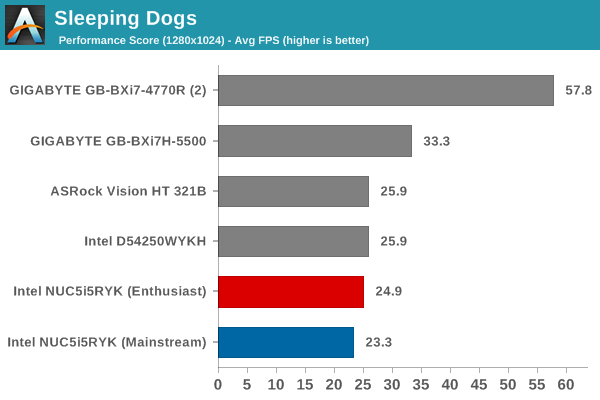
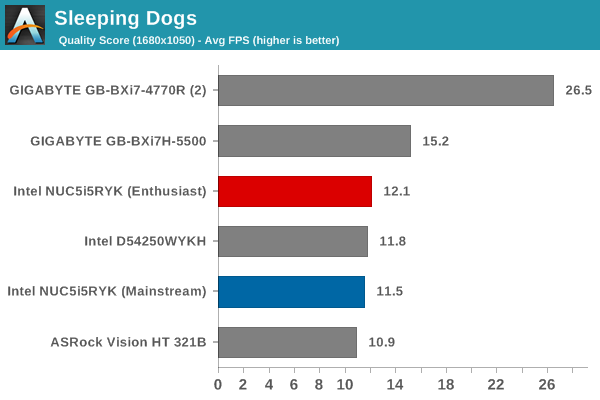

Tomb Raider
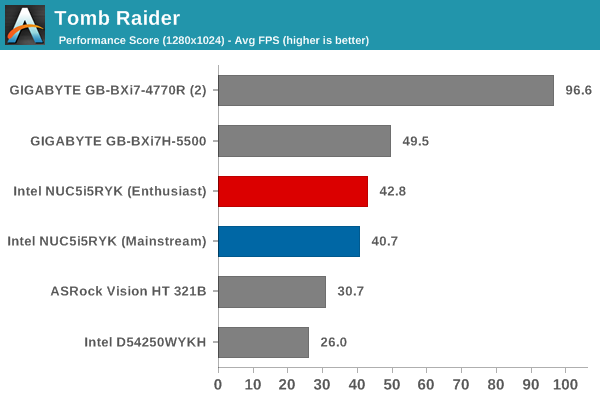
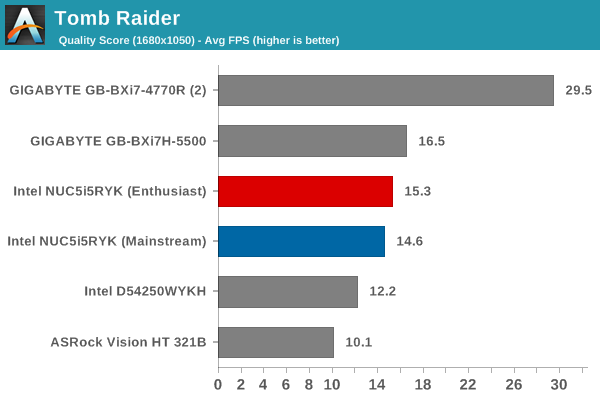
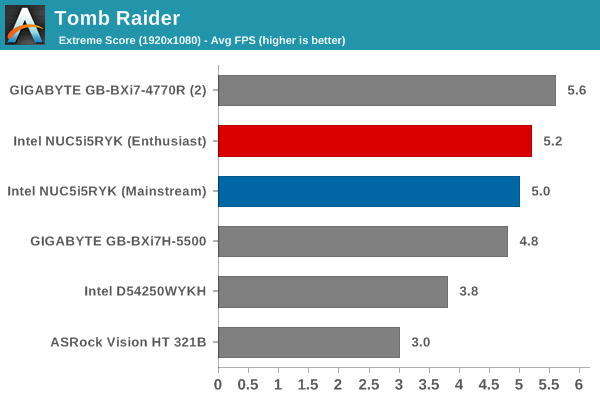
Bioshock Infinite
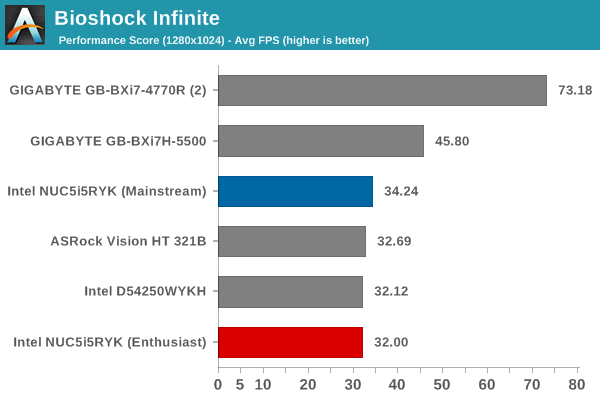
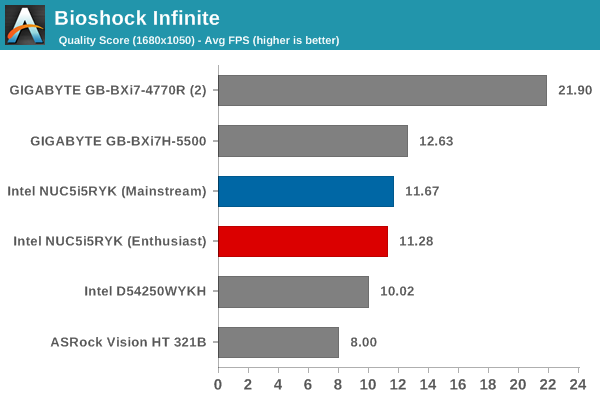
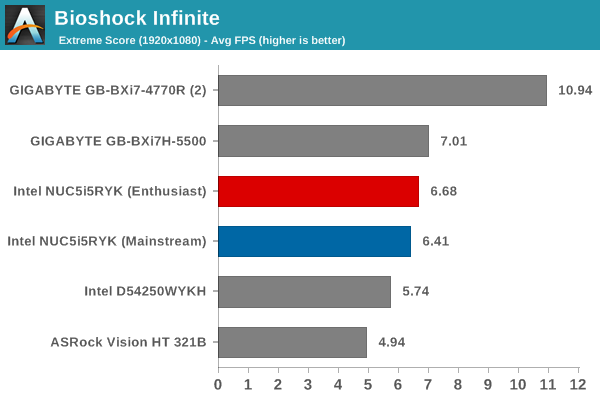
DiRT Showdown
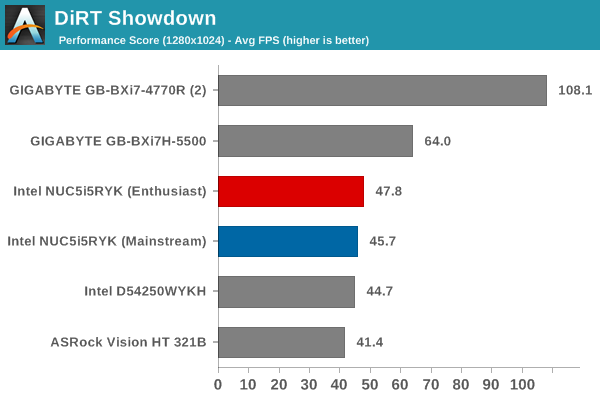
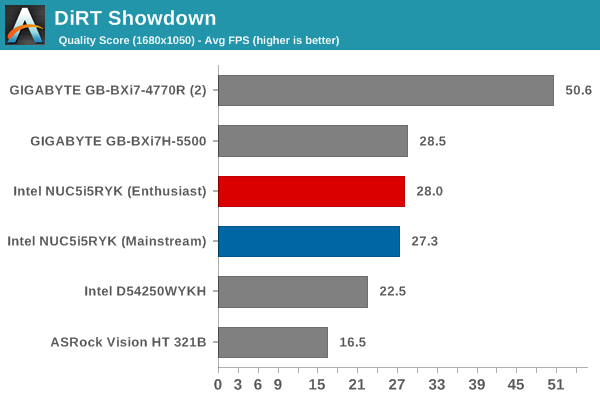
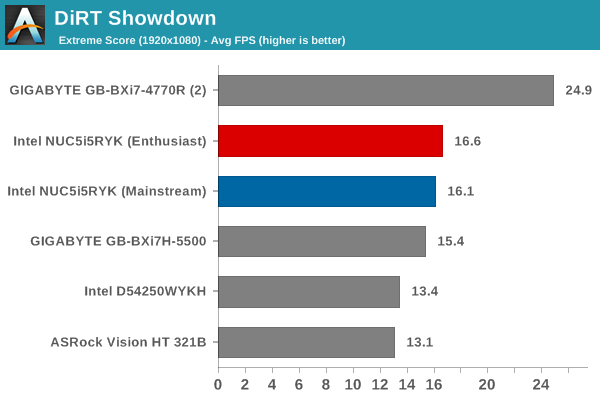
The gaming benchmarks, when considered as a showdown between the HD Graphics 5500 and HD Graphics 6000, is is a complete walkover for the former in the Core i7-5500U. Faster memory helps in salvaging a few FPS here and there, but the games are not fluid even with all settings dialed down. One aspect to be kept in mind while considering the above results is that the HD 5500 in the Core i7-5500U had accesses to DRAM running at 2133 MHz, while the HD 6000 in the NUC5i5RYK was limited to 1866 MHz.










83 Comments
View All Comments
cjs150 - Friday, February 20, 2015 - link
I am a confirmed HTPC user, I have 2 in the house. One, more powerful, is used to rip Blu rays down to NAS, (plus play, Netflix/Amazon Prime, Web browsing) the other is used simply to play movies, browising, word processing and "Old" gaming - I am a big fan of Total War, old versions.Total silent operation is a must. I do not care how quiet the fan is, in soft parts of movie playback I can hear it.
The old i3 NUC, in a fanless case, makes for an excellent low power HPTC. A Broadwell U will be as good.
My problem is then I am not sure even that power is necessary for most HTPC use where simply streaming from NAS or similar external disk. For the next HTPC I am looking forward to reviews of Intels Bay Tree on a stick, so small it could be stuck behind my AV receiver
edzieba - Friday, February 20, 2015 - link
Having 'too much' power for an HTPC has two main advantages:1) Interface speed. This is both for actual rendering of the interface bells & whistles, and for populating large directories when browsing.
2) CODEC futureproofing. H.265 is on the horizon, and Hi10p H.264 has some very nice benefits in bitrate reduction (or better perceptual quality at the same bitrate), but low power hardware that relies on fixed-function decoder blocks will be left high and dry. Even if they DO have a FFB for a desired CODEC, it may not be sufficient to playback all files (e.g. the number of Level 4.0 h.264 decoders that can't handle full-bitrate Blu Ray streams).
Kutark - Tuesday, February 24, 2015 - link
I'm not sure you realize how little processing power is actually used for rendering. Even now on an old dual core pentium my htpc barely hits 10% utilization on one core while watching h.264 stuff at 1080p. My second htpc which has a ~$55 amd 5xxx series card does most of it via the video card, which also is nowhere even close to being taxed.This setup is WWWAAAYYYY past the needs of any kind of streaming/media/htpc. At these price ranges you can actually build a pretty decent desktop with a dedicated graphics card. Yes, it won't be this small, but you will actually have real graphics performance (i.e. a gtx 960 or r9 280, etc).
yankeeDDL - Friday, February 20, 2015 - link
Wouldn't you consider an AMD-based system a better option for an HTPC? Asking as I am considering one.I recently bought an AMD-based laptop and I am extremely pleased with it as I find it much more effective for casual gaming and, frankly, the CPU performance gap with Intel is "irrelevant" for HTPC use (at least the one I have in mind).
cjs150 - Friday, February 20, 2015 - link
YankeeDDL: Short answer is yes, AMD laptop in many cases is a much better HTPC (unless it has a fan!)But will it look good with the rest of your AV kit? My main HTPC is in a HDPLEX 3 case, which looks great (but pricey), my second HTPC is an i3 NUC in a Tranquil fanless case - again fits right into the AV style.
I guess it depends on what you want. Edzieba is clearly much more of a power user of an HTPC than I am. That does make him right and me wrong (or vice versa), just different. But I have yet to find any user of an HTPC who, with all else being equal, would want to have fans in the HTPC if it could run fanless
Flunk - Friday, February 20, 2015 - link
So you're saying an AMD laptop isn't a better HTPC then? Qualifying it with "unless it has a fan" kinda negates the possibility entirely.
BlueBlazer - Saturday, February 21, 2015 - link
Fans have one big problem, dust accumulation and can lead to clogging (in the cooling vents) which can cause overheating.owan - Friday, February 20, 2015 - link
Its not about being a power user... he's talking about why more cpu punch can be a good thing. If you don't have a fixed function decode block for a new codec and your CPU is too crappy to do it in software, then you need to buy a new CPU and mobo. If bay trail on a stick can't do h.265 you're screwed if you try to play h.265 content, but a broadwell NUC might be able to do it in software (assuming it can't decode in hardware... which it may)BlueBlazer - Saturday, February 21, 2015 - link
Agree, I ran into that problem years ago especially with Hi10p (10-bit H.264) which requires software decoding. Those low power slow CPUs (like AMD E-350 and Atom 330) just would not be able to decode it smoothly. Broadwell already has H.265 as well as 10-bit H.265 and VP9 support in its latest drivers: http://techreport.com/news/27677/new-intel-igp-dri...rmullns08 - Friday, February 20, 2015 - link
cjs150: Interesting that you bring up the HDPLEX 3 case. I currently use a D54250WYKH, but have one major complaint with it being the power supply. I don't use mine as much for HTPC, but do use it for an audio setup (Schiit Modi2 Uber/Magni2 Uber and JBL LRS305), and the power supply is so noisy. I've found that the PSU leaks noise on the negative side, into the chassis which is not properly isolated or grounded. Connecting the DAC results in noise shooting through the system even before the USB cable makes actual contact with the NUC. I've tried different surge protectors, relocating devices onto different outlets to no avail. The other day I actually ordered the HDPLEX linear power supply to hopefully resolve the issue once and for all.